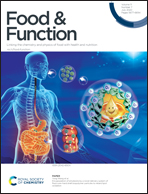Chitosan oligosaccharide ameliorated obesity by reducing endoplasmic reticulum stress in diet-induced obese rats†
Abstract
Objective: This study aimed to determine whether chitosan oligosaccharide (COST) improves overweight by reducing endoplasmic reticulum (ER) stress in the liver and liver cancer cells. Methods: An obesity model was established by feeding Sprague-Dawley rats (ORs) a high-fat diet (HFD) and treating them with COST for 8 weeks. A model of lipid accumulation in hepatocellular carcinoma cells was established by treating HepG2 cells with free fatty acids and COST for 24 h. Results: COST treatment of ORs reduced weight gain, inhibited adipose tissue hypertrophy and hyperplasia, and reduced the fat-to-weight ratio. COST improved dyslipidaemia, reduced liver weight and organ index, inhibited hepatic lipid accumulation, and prevented liver steatosis, and the high COST dose increased TC and TG excretion in the stool. Treatment of lipid accumulation in HepG2 cells with COST reduced lipid accumulation and TG levels. COST modulated the expression of genes related to fat metabolism and ER stress response pathway-related factors in liver tissue and HepG2 cells. Conclusions: COST can inhibit weight gain and improve dyslipidaemia and lipid metabolism in ORs. The COST-mediated regulation of hepatic and HepG2 cell lipid metabolism might be related to inhibition of fat synthesis, acceleration of lipid oxidative catabolism and reduction in ER stress.



 Please wait while we load your content...
Please wait while we load your content...